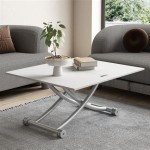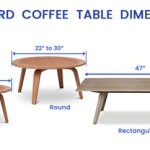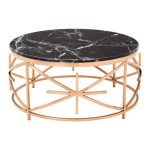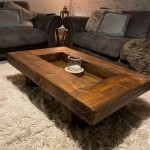The Enduring Appeal of the Arts and Crafts Style Coffee Table
The Arts and Crafts movement, emerging in the late 19th century as a reaction against the industrial revolution's mass-produced, often aesthetically lacking, goods, championed handcrafted items that emphasized quality, simplicity, and the beauty of natural materials. This philosophy extended to furniture design, giving rise to distinctive pieces like the Arts and Crafts style coffee table. These tables are more than just functional surfaces; they are embodiments of the movement's core values, showcasing skilled craftsmanship and a deep appreciation for form and function.
Arts and Crafts coffee tables are characterized by their sturdy construction, often employing exposed joinery and emphasizing the natural grain of the wood. The designs are generally straightforward and unadorned, eschewing elaborate ornamentation in favor of clean lines and honest materials. This aesthetic aligns with the movement's belief in the intrinsic beauty of natural resources and the importance of highlighting the maker's hand in the creation process. The resulting pieces possess a timeless quality that continues to resonate with contemporary design sensibilities.
The stylistic characteristics of an Arts and Crafts coffee table are identifiable and contribute to its overall appeal. It is important to understand what elements define this iconic style and what makes it a worthwhile addition to a variety of homes.
Key Features of Arts and Crafts Coffee Tables
Arts and Crafts coffee tables are defined by several key characteristics that reflect the movement's core principles. These features contribute to the tables' distinct aesthetic and enduring popularity.
Emphasis on Natural Materials: Wood is the primary material used in Arts and Crafts coffee tables. The selection of wood species is often deliberate, with oak being a common choice due to its strength, durability, and prominent grain pattern. Other woods like cherry, maple, and walnut may also be used, depending on the desired aesthetic and the availability of materials. The wood is typically finished with natural oil or wax, allowing the grain to show through and highlighting the material's inherent beauty. Paints and heavily lacquered finishes are generally avoided, as they obscure the natural character of the wood. The emphasis on natural materials extends beyond the wood itself. Hardware, such as drawer pulls and hinges, is often crafted from hand-forged iron or copper, further emphasizing the handcrafted nature of the piece.
Simple and Functional Design: The design of an Arts and Crafts coffee table prioritizes functionality and simplicity. The tables typically feature clean lines, right angles, and a straightforward construction. Ornamentation is minimal, with the focus placed on the quality of the materials and the precision of the craftsmanship. Complex carvings and elaborate inlays are rarely seen on authentic Arts and Crafts pieces. Any decorative elements that are present are usually integrated into the structure of the table, such as exposed joinery or subtly shaped legs. The functional aspect of the design is also carefully considered. Tables are often designed with ample surface area for everyday use and may include features such as drawers or shelves for storage. The overall goal is to create a piece that is both beautiful and practical, serving a clear purpose in the home.
Exposed Joinery: One of the most distinguishing features of Arts and Crafts furniture, including coffee tables, is the use of exposed joinery. Rather than concealing the connections between different pieces of wood, the joints are often intentionally highlighted as a decorative element. Common types of exposed joinery include mortise and tenon joints, dovetail joints, and pegged joints. These joints not only demonstrate the skill of the craftsman but also add visual interest to the piece. The exposed joinery also serves a structural purpose, providing strength and stability to the table. By showcasing the joinery, the Arts and Crafts style celebrates the construction process and emphasizes the handcrafted nature of the furniture.
Historical Context and Influences
Understanding the historical context of the Arts and Crafts movement is crucial for appreciating the design principles of its furniture, including the coffee table. The movement arose as a direct response to the perceived negative impacts of industrialization on craftsmanship and society.
Reaction to Industrialization: The late 19th century saw a rapid acceleration of industrial production, resulting in mass-produced goods that were often characterized by poor quality and a lack of artistic merit. The Arts and Crafts movement, spearheaded by figures like William Morris and John Ruskin, sought to counteract this trend by promoting handcrafted goods that emphasized quality, beauty, and functionality. The movement rejected the use of machines for mass production, advocating for a return to traditional craftsmanship and the use of simple, honest materials. The Arts and Crafts movement believed that by creating beautiful and well-made objects, they could improve the lives of both the makers and the users. This belief led to a renewed focus on the design and construction of furniture, with an emphasis on creating pieces that were both functional and aesthetically pleasing. The Arts and Crafts coffee table, with its emphasis on natural materials, simple design, and exposed joinery, embodies these core principles.
Influence of the Gothic Revival: The Arts and Crafts movement drew inspiration from a variety of sources, including the Gothic Revival movement. The Gothic Revival, which had gained popularity in the mid-19th century, emphasized the use of traditional building techniques and the incorporation of handcrafted details. The Arts and Crafts movement adopted some of these principles, advocating for the use of traditional joinery methods and the creation of furniture that showcased the skills of the craftsman. The Gothic Revival also influenced the Arts and Crafts movement's emphasis on honesty and integrity in design. Both movements believed that the structure and construction of an object should be visible and celebrated, rather than concealed. This principle is evident in the exposed joinery that is often found on Arts and Crafts furniture.
Emphasis on Simplicity and Honesty: The Arts and Crafts movement valued simplicity and honesty in design. This meant that furniture should be functional and unpretentious, with no unnecessary ornamentation or embellishment. The movement believed that the beauty of an object should derive from its inherent qualities, such as the natural grain of the wood and the precision of the craftsmanship. This emphasis on simplicity and honesty is reflected in the design of the Arts and Crafts coffee table, which typically features clean lines, a straightforward construction, and minimal ornamentation. The movement also promoted the use of natural materials that were locally sourced and sustainably harvested. This emphasis on sustainability reflects the Arts and Crafts movement's broader concern for the environment and the impact of industrial production on the natural world.
Materials and Craftsmanship
The materials used and the craftsmanship employed in creating Arts and Crafts coffee tables are paramount to understanding their value and character.
Wood Selection and Preparation: The selection of wood is a critical aspect of crafting an Arts and Crafts coffee table. Oak is a common choice, favored for its strength, durability, and distinctive grain pattern. However, other hardwoods such as cherry, maple, and walnut are also frequently used. The wood is carefully selected for its quality, grain pattern, and absence of defects. It is then properly dried and seasoned to prevent warping or cracking. The preparation of the wood involves cutting the pieces to the required dimensions and shaping them according to the design. This process often involves the use of traditional woodworking tools, such as hand planes, chisels, and saws. The emphasis is on precision and accuracy, ensuring that the pieces fit together perfectly. The careful selection and preparation of the wood are essential for creating a sturdy and long-lasting coffee table.
Joinery Techniques: The joinery techniques used in Arts and Crafts coffee tables are a testament to the skill and craftsmanship of the maker. Traditional joinery methods, such as mortise and tenon joints, dovetail joints, and pegged joints, are employed to create strong and durable connections between the different pieces of wood. These joints are often exposed, showcasing the craftsmanship and adding visual interest to the piece. The mortise and tenon joint involves inserting a projecting tenon from one piece of wood into a corresponding mortise (hole) in another piece. This type of joint is particularly strong and is often used to connect the legs to the table top. Dovetail joints are used to create strong and interlocking connections between the sides of drawers or the corners of the table frame. Pegged joints involve inserting wooden pegs into pre-drilled holes to secure the connection between two pieces of wood. These joinery techniques require precision and attention to detail, and they are essential for creating a coffee table that will withstand the test of time.
Finishing and Detailing: The finishing and detailing of an Arts and Crafts coffee table are crucial for enhancing its beauty and protecting the wood. The table is typically finished with natural oil or wax, allowing the grain to show through and highlighting the material's inherent beauty. Paints and heavily lacquered finishes are generally avoided. The finishing process involves sanding the wood smooth and applying several coats of oil or wax. Each coat is allowed to dry completely before the next coat is applied. The finished surface is then buffed to a smooth and lustrous sheen. Detailing may include adding decorative elements, such as hand-forged iron or copper hardware. Drawer pulls and hinges are often crafted from these materials, adding a touch of elegance and sophistication. The finishing and detailing process is carefully executed to ensure that the coffee table is both beautiful and durable.
Overall, the enduring appeal of the Arts and Crafts style coffee table lies in its embodiment of quality craftsmanship, simple design, and honest materials. These pieces represent a rejection of mass-produced goods and a celebration of the maker's hand, resulting in furniture that is both functional and aesthetically pleasing.

Craftsman Style Coffee Table Arts And Crafts Furniture Mission

Charming Arts Crafts Coffee Table Digital Plan

Prairie Mission Coffee Table Barn Furniture

Mission Oak Arts Crafts Stickley Style Coffee Cocktail Table

Mission Style Arts Crafts Solid Quarter Sawn Oak Coffee Table Crafters And Weavers

Arts Crafts Coffee Table

Mission Style Coffee Table Arts And Crafts

Antique 1910s Mission Arts Crafts Draw Leaf Oak Coffee Table Chairish

Sold At Auction Arts Crafts Style Oak Wood Coffee Table

Country View Amish Handcrafted Arts And Crafts Mission Oak Cocktail Table For At 1stdibs Coffee







